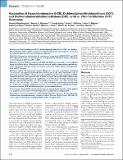Association of Hexachlorobenzene (HCB), Dichlorodiphenyltrichloroethane (DDT), and Dichlorodiphenyldichloroethylene (DDE) with in Vitro Fertilization (IVF) Outcomes

View/
Author
Mahalingaiah, Shruthi
Maity, Arnab
Meeker, John D.
Berry, Katharine
Ehrlich, Shelley
Perry, Melissa J.
Note: Order does not necessarily reflect citation order of authors.
Published Version
https://doi.org/10.1289/ehp.1103696Metadata
Show full item recordCitation
Mahalingaiah, Shruthi, Stacey A. Missmer, Arnab Maity, Paige L. Williams, John D. Meeker, Katharine Berry, Shelley Ehrlich, et al. 2012. Association of Hexachlorobenzene (HCB), dichlorodiphenyltrichloroethane (DDT), and dichlorodiphenyldichloroethylene (DDE) with in Vitro Fertilization (IVF) outcomes. Environmental Health Perspectives 120(2): 316-320.Abstract
Background: Hexachlorobenzene (HCB), dichlorodiphenyltrichloroethane (DDT), and dichlorodiphenyldichloroethylene (DDE) are persistent chlorinated pesticides with endocrine activity that may adversely affect the early stages of human reproduction. Objective: Our goal was to determine the association of serum levels of HCB, DDT, and DDE with implantation failure, chemical pregnancy, and spontaneous abortion in women undergoing in vitro fertilization (IVF) from 1994 to 2003. Methods: Levels of HCB and congeners of DDT and DDE were measured in serum collected during the follicular phase. Multivariable-adjusted statistical models accommodating multiple outcomes and multiple cycles per woman were used to estimate the relation between serum pesticide levels and IVF outcomes. Results: A total of 720 women with a mean \(\pm\) SD age 35.4 \(\pm\) 4.2 years at enrollment contributed 774 IVF cycles. All samples had detectable levels of HCB, DDT, and DDE, with median levels of 0.087 ng/g serum for HCB, 1.12 ng/g serum for total DDT, and 1.04 ng/g serum for p,p´-DDE. Compared with the lowest quartile (Q1) of HCB, the lipid- and multivariable-adjusted odds ratio (OR) for failed implantation was significantly elevated for those with higher HCB quartiles [Q2–Q4; adjusted ORs: for Q2, 1.71; 95% confidence interval (CI): 1.03, 2.82; for Q3, 2.30; 95% CI: 1.39, 3.81; for Q4, 2.32; 95% CI: 1.38, 3.90] and showed a significantly increasing trend (p = 0.001). No statistically significant associations were observed between DDT/DDE and IVF outcomes or between HCB and chemical pregnancy or spontaneous abortion. Conclusions: Serum HCB concentrations were on average lower than that of the general U.S. population and associated with failed implantation among women undergoing IVF.Other Sources
http://www.ncbi.nlm.nih.gov/pmc/articles/PMC3279437/pdf/Terms of Use
This article is made available under the terms and conditions applicable to Other Posted Material, as set forth at http://nrs.harvard.edu/urn-3:HUL.InstRepos:dash.current.terms-of-use#LAACitable link to this page
http://nrs.harvard.edu/urn-3:HUL.InstRepos:10288631
Collections
- HMS Scholarly Articles [17922]
- SPH Scholarly Articles [6362]
Contact administrator regarding this item (to report mistakes or request changes)


